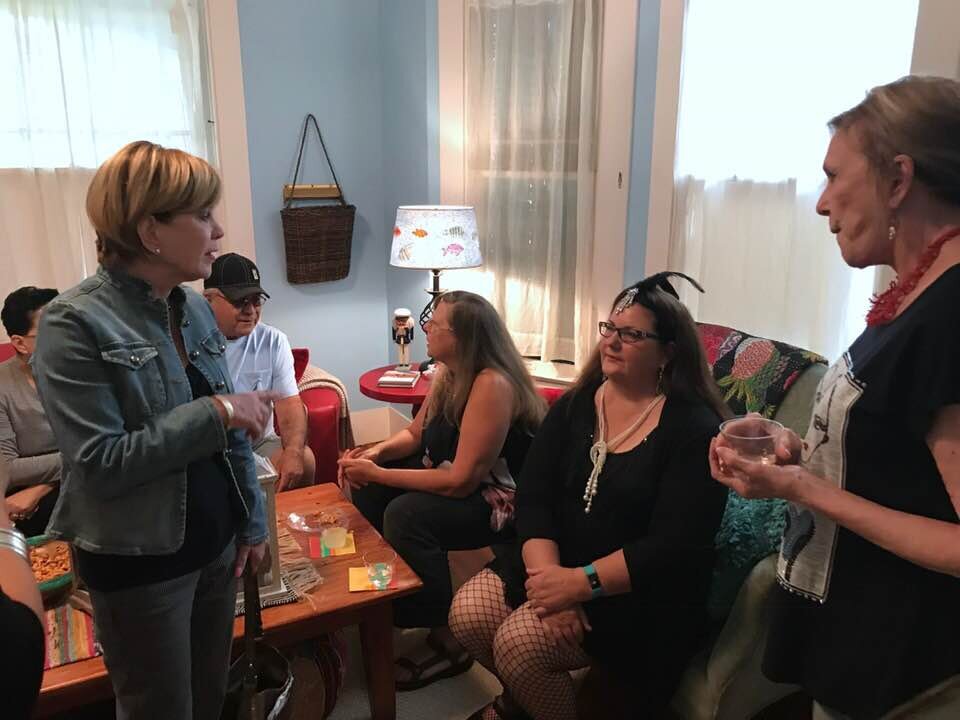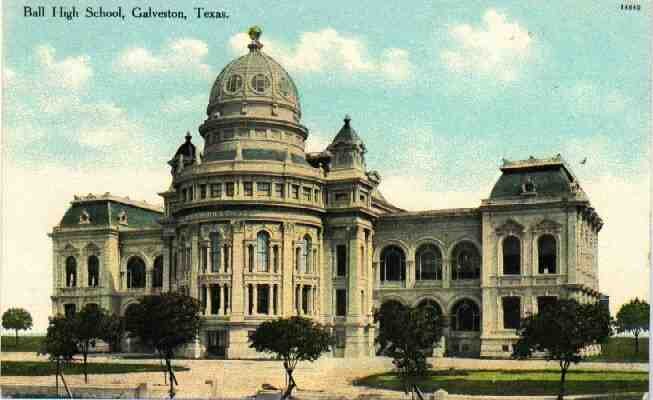Ashton Villa
The 1859 Ashton Villa, a fully restored historic home, was the first of Galveston’s great mansions built on Broadway Boulevard. Since its completion, it has been at the center of the island’s social life.
On January 7, 1859, Colonel James Moreau Brown, a prominent hardware merchant and banker, purchased four lots on Broadway on which to build a home. Referencing architectural pattern books current at the time, he modified several plans to design his future home. Using slave labor and European craftsmen, Brown proceeded to build one of the first brick structures in Texas.
The three-story house was built in Victorian Italianate style, with deep eaves, long windows and ornate verandas that were topped by lintels made of cast iron. The brick walls were made 13 inches thick, to help protect against humidity and add strength to the structure. The interior of the home was laid out and designed around a central hall floor plan. Brown's wife, Rebecca Ashton, named the home in honor of one of her ancestors, Lt Issac Ashton, a hero in the U.S. Revolutionary War.
The house was completed in 1861. When the Civil War began, the home became the headquarters for the Confederate Army and served in that capacity for the entire war, except for a brief period in the fall of 1862. At that time, Galveston was surrendered to the Union Army, which made Ashton Villa its headquarters. The Union's occupation was short lived, however, as Galveston was re-taken by the Confederates during the Battle of Galveston in January 1863.
Brown died in 1895, just five years before the Great Storm of 1900 devastated Galveston. Ashton Villa, however, managed to withstand the storm's winds and infamous storm surge, while serving as shelter to Brown's widow and children. In the storm's aftermath and grade raising of the city, its basement was filled in with sand, and the surrounding grounds were topped with two feet of soil.
Ashton Villa was sold in 1927 to the El Mina Shrine masonic order. The house served as its business offices and meeting hall until 1970, when it was offered for sale. Under the threat of demolition, the Galveston Historical Foundation raised $125,000 to purchase Ashton Villa. With additional funding from local foundations and the government, the process of restoring and refurnishing the home began. On July 25, 1974, the Galveston Historical Foundation opened the home to the public to serve as a House Museum, visitors center and a place for special functions.
Ashton Villa is listed on the National Register of Historic Places and is a Recorded Texas Historic Landmark.
-
2022
- Mar 17, 2022 Ivy Dishes
- Jan 29, 2022 Grace Episcopal Church
- Jan 1, 2022 100 Years
-
2021
- Aug 25, 2021 My Fig Tree
- Apr 28, 2021 Darlene's Shrimp
- Apr 24, 2021 Oleander Festival
- Feb 27, 2021 Great Winter Storm
- Feb 10, 2021 The Mourning Wave
-
2020
- Oct 26, 2020 Crepe Myrtles
- Sep 18, 2020 Trimming the Palms
- Jul 19, 2020 The Dancers
- Jul 11, 2020 Postcards
- Jun 20, 2020 Resilience Flag
- Jun 19, 2020 Juneteenth
- Jun 10, 2020 Silk Stocking
- May 27, 2020 Tree Sculptures
- May 6, 2020 Babe's Beach
- Apr 22, 2020 Opera House
- Mar 2, 2020 Texas Heroes Monument
- Feb 15, 2020 Mardi Gras Parade
- Jan 19, 2020 St. Joseph's Church
-
2019
- Dec 15, 2019 Celebrations
- Nov 6, 2019 Fresh Paint
- Oct 21, 2019 Jazz Age Series
- Oct 20, 2019 ARToberFEST
- Oct 6, 2019 Stingeree
- Oct 5, 2019 Pumpkin Time
- Oct 2, 2019 Sea Turtles
- Sep 29, 2019 Powhatan House
- Sep 24, 2019 The Dolphins
- Sep 5, 2019 Lucas Apartments
- Aug 24, 2019 Sandcastles
- Aug 9, 2019 The Daily News
- Jul 18, 2019 Beach Walk
- Jul 10, 2019 La King's
- May 25, 2019 Pleasure Pier
- May 1, 2019 Bolivar Ferry
- Mar 15, 2019 Saengerfest Park
- Jan 19, 2019 Moody Mansion
-
2018
- Dec 18, 2018 The Vintage Suitcase
- Dec 17, 2018 Festival of Lights
- Dec 2, 2018 Sunday Brunch
- Nov 21, 2018 Hendley Row
- Oct 27, 2018 Island Oktoberfest
- Sep 20, 2018 The Strand Clock
- Sep 16, 2018 St. Mary Cathedral
- Aug 11, 2018 No More Shed
- Jun 10, 2018 Rosenberg Library
- May 7, 2018 Stepping It Up
- May 3, 2018 A Happy Hour
- May 1, 2018 Ashton Villa
- Apr 21, 2018 96th Birthday
- Apr 1, 2018 Seawolf Park
- Mar 27, 2018 Ball High School
- Mar 15, 2018 East End
- Feb 1, 2018 Tremont House
- Jan 26, 2018 Menardi Gras
- Jan 24, 2018 Mardi Gras Decor
-
2017
- Dec 1, 2017 Miss Ruby
- Oct 8, 2017 Railroad Museum
- Oct 7, 2017 Tall Ship Elissa
- Sep 9, 2017 Star Drug Store
- Sep 8, 2017 1900 Storm Statue
- Aug 6, 2017 The Turquoise Table
- Aug 1, 2017 Bishop's Palace
- Jul 23, 2017 Garten-Verein
- Jul 21, 2017 Yard Work
- Jul 16, 2017 The Strand
- Jun 17, 2017 Stewart Beach
- Jun 7, 2017 The Original
- Jun 3, 2017 Murdochs
- May 27, 2017 Bryan Museum
- May 19, 2017 Firemen on Call
- May 13, 2017 Williams-Borden Neighborhood
- May 1, 2017 Oleander City
- Apr 28, 2017 God Winks















